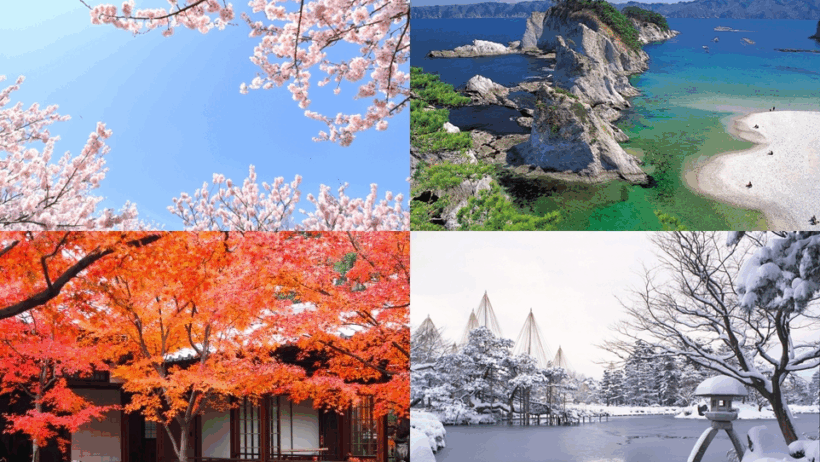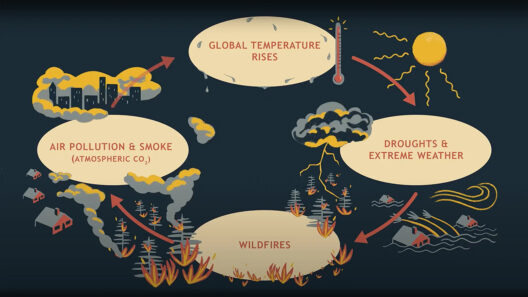Japan, an archipelago of over 6,800 islands, possesses a climate that is as intricate as a traditional kimono—each layer revealing a new pattern of diversity and complexity. The Japanese climate oscillates between the distinct four seasons: spring, summer, autumn, and winter, each distinct not only in temperature but in the cultural phenomena they herald. These seasons are akin to a masterful brush painting, where hues of nature vary from the vivacious pinks of cherry blossoms to the stark whites of winter’s serene snowfall. Understanding this intricate climatic tapestry is key to appreciating Japan’s natural beauty and cultural ethos.
Spring in Japan, known as ‘haru’, is heralded by the effulgent arrival of cherry blossoms—sakura—which transform the landscape into a pastel wonderland. This season typically spans from March to May, where temperatures range from a gentle 10°C to a balmy 20°C. It offers a delightful respite from the chill of winter, breathing life back into dormant flora and fauna. The ephemeral beauty of the cherry blossoms symbolizes renewal and the fleeting nature of existence, making hanami (flower viewing) a cherished cultural practice. Parks and riversides are adorned with festivals, drawing locals and tourists alike, each reveling in the transience of beauty with a sense of deep, philosophical introspection.
As spring retreats, summer bursts forth with unabashed enthusiasm. This season, extending from June to August, is characterized by debilitating humidity and sweltering temperatures often soaring above 30°C. Japan’s geography plays a pivotal role in summer’s intensity; the surrounding seas generate moist air, while mountainous terrain can trap heat, fostering a sultry atmosphere. Summer is also the season of typhoons, swirling storms that can wreak havoc yet are an intrinsic part of life, encapsulating a duality of destruction and creation. Festivals flourish during this time, with fireworks lighting up the night skies, embodying the lively spirit of the Japanese people. These bright spectacles offer a contrast to the oppressive heat, reflecting the resilient nature of a populace that finds joy even amid adversity.
As summer’s fervor begins to wane, autumn, or ‘aki’, graces Japan with a breathtaking transformation. Spanning September to November, it introduces a cooler climate, ranging from 15°C to 25°C. Nature dons a vibrant cloak of red, orange, and golden hues, signaling a time of harvest and appreciation. The celebration of the moon in autumn—Tsukimi—epitomizes the Japanese reverence for nature’s cycles. As the full moon illuminates the cool night air, families gather to admire its beauty, an embodiment of gratitude for the year’s bounty. The serenity of autumn invokes a contemplative muse, reminding observers of the transient nature of life and the beauty in impermanence.
Once autumn yields to winter, Japan showcases an entirely different visage. The period from December to February sees the country blanketed in white; however, this season unfolds differently in various regions. In places like Hokkaido, heavy snow transforms the landscape into a dazzling white wonderland, perfect for skiing and winter festivals. Conversely, the milder winters of the southern regions, such as Kyushu, see temperatures hovering around 5°C to 15°C, where the landscape, though less icy, retains a serene beauty. The Japanese concept of ‘yukimi’, or viewing the snow, captures the enchantment of witnessing nature’s quietude, a calm disruption in an often-chaotic world. Winter’s chill, while formidable, breeds an appreciation for warmth—both physical and emotional—as families flock indoors, sharing stories and meals, deepening familial bonds.
Japan’s climate is not simply a backdrop to its seasons but a pivotal character in the ongoing narrative of its culture and identity. The interplay of meteorological elements significantly influences traditional agricultural practices, arts, and even spiritual beliefs. For instance, rice cultivation, a staple of the Japanese diet, is intimately linked to seasonal cycles, with farmers working in tandem with the whims of nature. Festivals correlate with these agricultural rhythms, celebrating the harvest and recognizing the challenges posed by unpredictable weather.
However, a pressing concern looms over the traditional understanding of Japan’s climate—the implications of climate change. The country is facing increasingly erratic weather patterns, from rising sea temperatures that affect marine biodiversity to altered rainfall patterns disrupting the delicate balance of agriculture. The once predictable rhythm of the seasons is being thrown into disarray, challenging the very foundations of cultural practices tied to these natural phenomena. As droughts give way to torrential downpours and typhoons grow in strength, Japan finds itself at a precarious crossroads. The urgency for environmental stewardship has never been more pronounced, and there is a pressing need for collective action to mitigate these challenges.
In conclusion, the Japanese climate is a swirling narrative of beauty, tradition, and challenge. Each season serves as an expression of nature’s poetry, illustrating not just the physical environment but the cultural and emotional landscapes shaped by it. As the cherry blossoms bloom and the snowflakes fall, they invite reflection on the delicate fragility of life—a continuous cycle of death and rebirth. In embracing this intricate climate tapestry, there lies an inherent responsibility to protect and preserve these precious ecosystems, ensuring that future generations can also partake in the seasonal wonders that define the essence of Japan.








